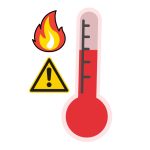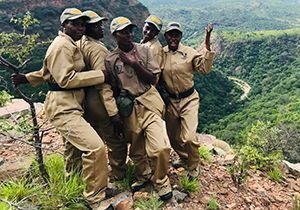Celebrating 170 years of the Met Office
The UK’s national weather service has been helping us plan for rain and shine since 1854!
It’s often said that talking about the weather is a British national obsession. So, it’s no wonder that since the 19th century, the UK has had its own organisation dedicated to predicting whether we need to grab a brolly or stick on sunglasses.
However, the Met Office does much more than that – from forecasting conditions for seafaring ships to helping us track the health of our planet.
To celebrate its 170th birthday, take a look the timeline below to see how the Met Office became the organisation we know today…
1854
The Met Office is founded
10 nations (including Great Britain) met in Brussels, Belgium for the first ever International Meteorological Conference in 1853. Their aim was to agree a system for observing and logging weather conditions at sea. Just a year later in 1854, the UK parliament founded the organisation that would later be called the Met Office based on this!
1859
A national storm warning system is created
A huuuge storm at sea took 800 lives and destroyed 133 ships – including a very famous ship named the Royal Charter. The public were outraged! The head of the Met Office, Captain Robert Fitzroy, produced a detailed report, proving the storm could have been predicted and disaster prevented. So, a national storm warning system was created and, in 1861, the first storm warning was issued.
1861
The first public weather forecast is printed
Robert was able to compile weather observations from stations dotted around the coast from the comfort of his London office, all thanks to a fancy new messaging technology called the electric telegraph. He soon realised this data would be useful for the public too, and the first weather forecast was published in the Times newspaper in 1861. Woohoo!

1873

Worldwide weather prediction rules are established
Meteorologists (weather scientists) from the Met Office and around the world met once again – this time in Vienna (capital of Austria). They decided it was important to establish a set of standard techniques, definitions and even symbols for weather prediction. In 1879, the International Meteorological Organization (later the World Meteorological Organization) was born.

1922

The first radio weather forecast
Technology was developing very quickly. In 1922, the Met Office’s first radio weather forecast took place, changing the way people accessed weather info forever. The forecast: Calm or light winds with fair periods and rather cold across England. Slightly windier, occasional rain and mild for Scotland and Ireland. Typical British weather then!

1944

Weather forecasts help end World War II
During World War II, Britain and its allies planned a vital operation in Normandy, France – known as the D-Day Landings. However, bad weather could easily scupper their plans. A team of meteorologists, led by Met Office forecaster James Stagg, advised the army to delay for one day. Thanks to this, Britain was able to win the battle and eventually the war. The decision saved countless lives, making it perhaps one of the most important weather forecasts of all time!

1954

The first live television weather forecast
TV was quickly becoming the hottest new technology – partly thanks to people scrambling to watch the glitzy coronation of Queen Elizabeth II in 1953. And by 1954, 3.2 million Brits had TV licences. That year, meteorologists George Cowling and Tom Clifton were selected to become the first ever TV weathermen. Weather presenters have been appearing on our screens ever since!

1960

The first weather satellite launched
The first weather satellite, called TIROS1, was launched into space in 1960. This meant meteorologists could see large areas of the Earth’s surface for the very first time. Thanks to this, they could now see complete weather systems, helping forecasts become much more accurate.

1986

A nuclear disaster
Tragedy struck in 1986 when the Chernobyl Nuclear Power Plant in Ukraine went into meltdown, releasing lots of dangerous radioactive material into the atmosphere. In response, the Met Office created the Numerical Atmospheric-dispersion Modelling Environment (NAME). This tool not only helps predict the impact a nuclear accident might have around the globe, but also volcanic eruptions, chemical accidents, smoke from fires, odours, airborne animal diseases and general air pollution. Wow!

1990

A centre for climate science is opened
The Met Office Hadley Centre – a centre dedicated to researching the Earth’s climate – was opened. It provides vital advice to both the UK and world governments about how our climate is changing, the effects this is having and how we can tackle it.

2010

The Met Office app is launched
The Met Office app was launched, with an updated version coming along in 2016. This helped the public get access to weather forecasts whenever and wherever they want! For example, if you’re on your way to the beach with nothing but your swimsuit and towel, the Met Office app has you sorted – you can check it on the bus and head back quickly if rain is coming. It’s like having a weather expert in your pocket!

2014

The Space Weather Operations Centre is launched
You might not realise that space has its own weather, but changing conditions can have a BIG impact for our lives on Earth. The Sun is constantly changing and ejecting particles, electromagnetic energy and magnetic fields. This can be very disruptive for things like satellites, power grids and radio communications. In 2014, the Met Office Space Weather Operations Centre was opened to help safeguard the UK from the effects of space weather events.

2015

The Met Office starts naming storms
Giving names to potentially dangerous storms raises awareness and helps people track them on TV and social media. The Met Office decided to name its first storm (Abigail) in 2015 and has been doing so ever since. Has one ever had the same name as you?

2022
The UK’s highest ever temperature recorded

A sizzling 40.3°C was recorded by the Met Office at Coningsby, Lincolnshire on 19 July 2022 – the hottest UK temperature ever recorded. Yikes! Thankfully, as climate change means these extreme weather events become more frequent, the Met Office will be there to help us prepare.
Find out more about the Met Office at metoffice.gov.uk

More Like General Science

All about the circular economy

Summertime science fun at The Royal Institution!

RASPBERRY PI FOUNDATION’S CREATIVE CHALLENGE FAVOURITES!














LEAVE A COMMENT
THANK YOU
Your comment will be checked and approved shortly.
WELL DONE,
YOUR COMMENT
HAS BEEN ADDED!
COMMENTS1
So cool
CUSTOMIZE YOUR AVATAR